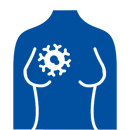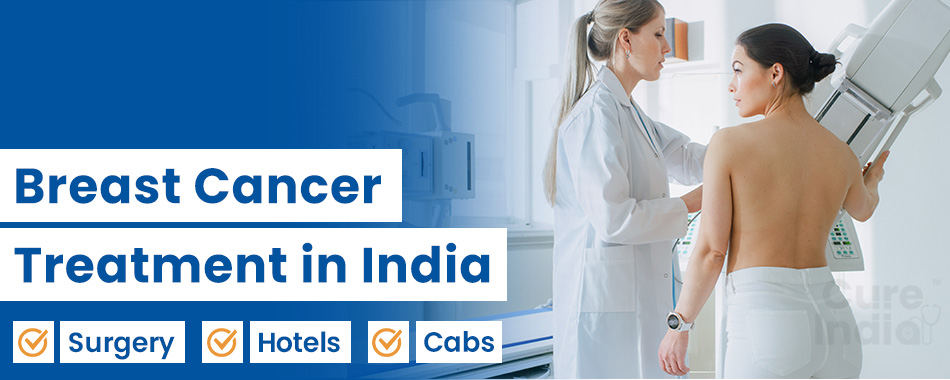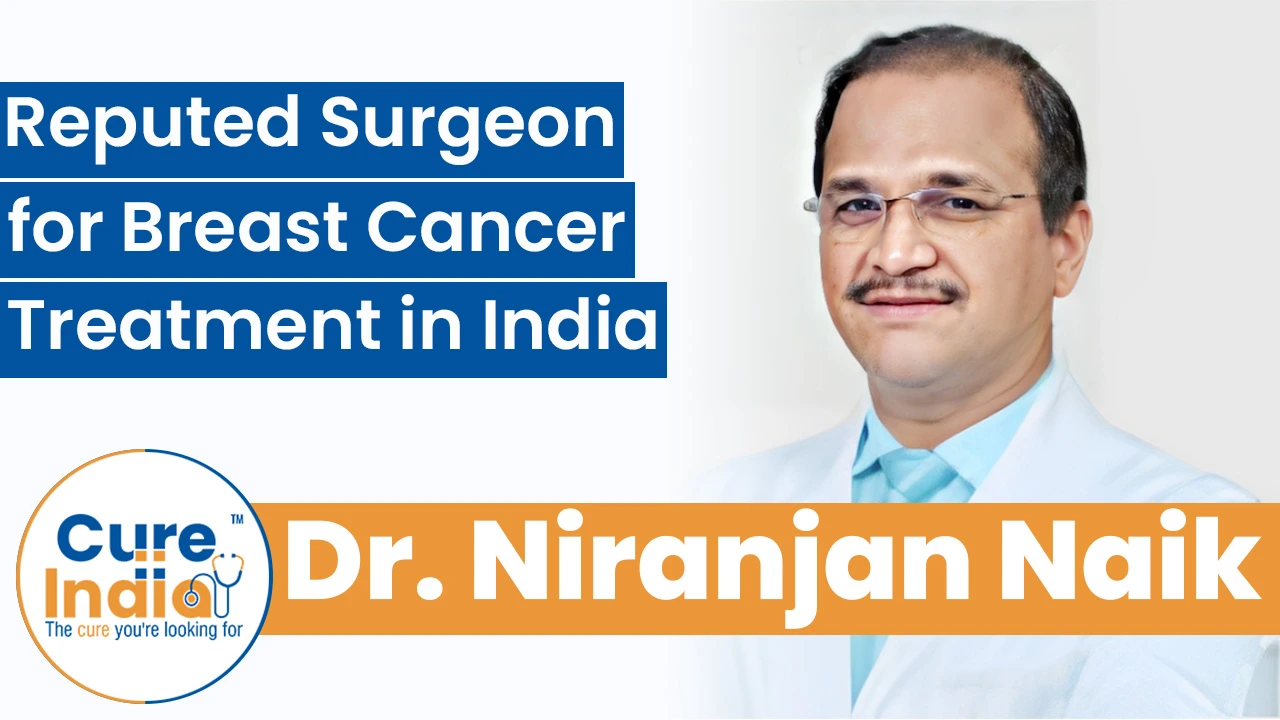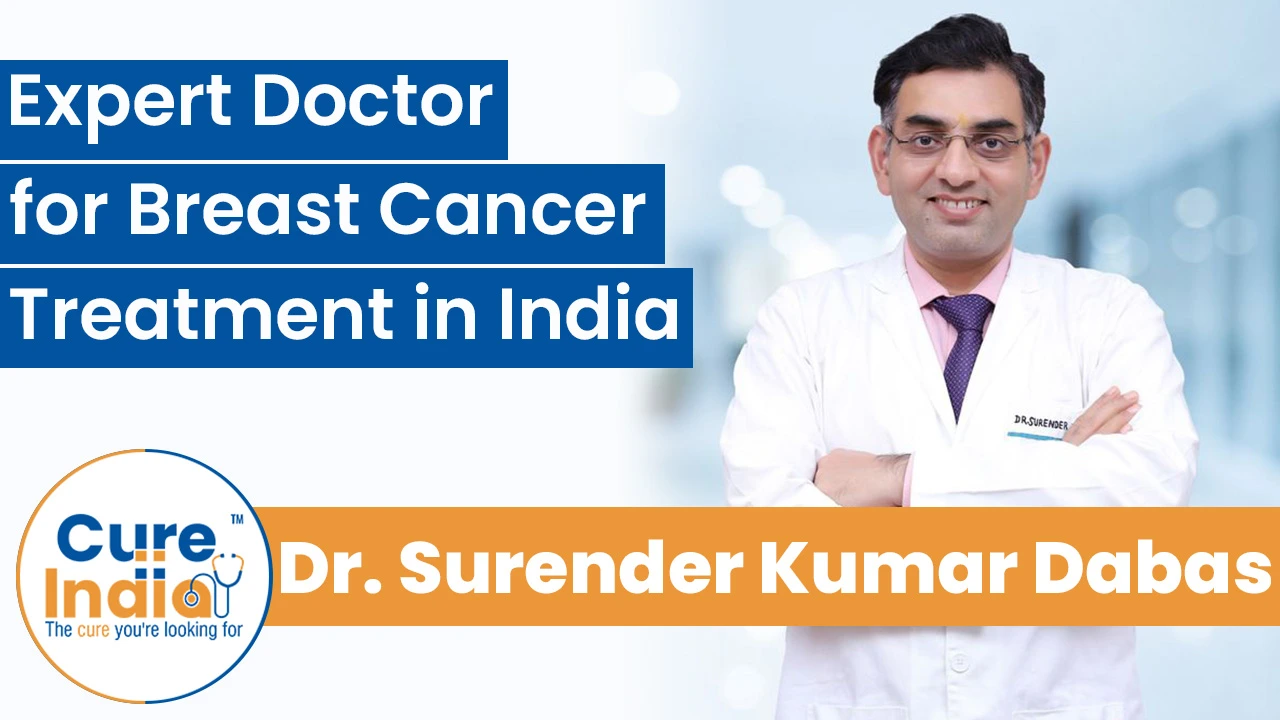

Breast cancer is a cancer that arises in the breast tissues. A breast is made up of different types of tissues and the three main parts of breasts are lobules, connective tissues, and ducts. The lobules in the breasts are the glands that produce milk, ducts carry the milk to the nipples, and the connective tissues are the fibrous fatty tissues that surround the lobules and ducts and hold them together.

Breast cancer occurs when the cells of the breast tissues start growing and multiplying uncontrollably. Breast cancer is of different types depending on in which cell the cancer develops. If early diagnosis and treatment are not initiated, the cancer can spread from the breasts to the other organs of the body through the blood vessels and the lymph nodes. The spread of cancer from one organ to other organs of the body is known as metastasis.
Breast cancer is the most common type of cancer that occurs in women in Sub-Saharan Africa. It affects nearly 129,000 African women in a year. The management of breast cancer in high-income countries is sufficient. However, many countries in Sub-Saharan Africa have a very low survival rate of breast cancer. It has been estimated that the incidence rate of breast cancer will increase by the year 2040 in Sub-Saharan Africa due to ageing and population expansion.
Most of the cases of breast cancer in African countries are diagnosed at an advanced stage. Breast cancer is a slow-growing cancer. It takes several months for the cancer to develop. That means that most of the women in Africa are receiving late diagnoses.
.jpg)
In African countries, the majority of women (59 to 90 per cent) are diagnosed with regional and metastatic cancer, and many women who have been pregnant within the past 3 years are diagnosed with an advanced stage of breast cancer because the early-stage symptoms of breast cancer were mistaken for and considered a lactation problem.
These women are diagnosed at an advanced stage of cancer, not because they didn’t notice the symptoms at an early stage. However, they did notice the symptoms and sought help when they had noticed the early-stage symptoms but received delays in diagnostic procedures. Many women in countries like Uganda, Zambia, etc. are reported to have symptoms for more than 6 months. However, they didn’t receive proper diagnosis due to an insufficient healthcare system.
In addition to this, due to the fears of treatment, financial barriers, myths, lack of breast cancer awareness, and disbelief that breast cancer is a curable disease, the majority of women don’t receive efficient treatment. And that’s why many women die due to a lack of proper diagnosis and treatment availability.
Seeking the correct and early diagnosis, many women with the symptoms of breast cancer from African countries like Zambia, Uganda, Cameroon, and Ghana travel to India as correct diagnostic and sufficient treatment tools are available in India at a much lower cost.
Indian cancer hospitals have the most advanced infrastructure and the most modern treatment protocols, along with innovative and modern diagnostic and therapeutic machines and medical devices, which help provide the best possible breast cancer treatment in the world.
The oncologists in Indian cancer hospitals are highly experienced and are globally trained doctors who are very knowledgeable and skilled in their particular area. Good quality treatments are available in other countries also, but the cost is so high that it is not affordable for the majority of international patients.
Only the breast cancer treatment cost is more than the affordable range. The travel cost is also added and hence the total cost rises so much that international patients can't travel and receive the treatments in these countries. Hence, India to the rescue. Treatment costs in India along with the travel cost are so affordable. Thus, India has become a medical hub for breast cancer patients.
.jpg)
There are many different breast cancer types along with their subtypes. Most of the cases of breast cancer are adenocarcinomas which means the cancer develops in the ducts and glands that secreats or carry the fluids such as milk. The different breast cancer types are as follows.
Invasive breast cancer is a cancer that spreads from its original site such as the lobules, ducts, etc., and spreads in the nearby breast tissues such as the lymph nodes and other distant organs through the bloodstream and lymphatic system. The subtypes of invasive breast cancer are listed below.
■ Invasive ductal carcinoma (IDC): It is the most common breast cancer type. About 78 to 80 percent of breast cancer cases are of this type. This cancer starts in the ducts present in the breast that carry the milk from the lobules to the nipples. The cancer grows and spreads into the other parts of the breast and it may also spread to the other organs of the body.
■ Invasive lobular carcinoma (ILC): It is the second most common breast cancer type. About 5 to 10 percent of breast cancer cases are of this type. This cancer starts in the lobules present in the breasts that produce the milk. The cancer can spread to the other part of the breast and it may also spread to the other organs of the body. This type of cancer is hard to detect in the mammograms and most women who are diagnosed with ILC have cancer in both of the breasts.
■ Paget’s disease of the breasts: It is also known as Paget’s disease of nipples. It is a rare breast cancer type. Only about 1 to 4 percent of breast cancer cases are of this type.
■ Angiosarcoma of the breasts: It develops in the lining of the blood vessels and the lymph nodes. It is a very rare breast cancer type. Only about 1 to 2 percent of breast cancer cases are of this type. It mostly affects people who are 70+ years of age. It grows rapidly and can spread in the other organs of the body.
■ Phyllodes tumors: It is the cancer that develops in the connective tissues present in the breasts. This type of cancer mostly affects women who are around 40 years of age. People with Li-Fraumeni syndrome have a high risk of developing this type of cancer.
There are many other types of invasive breast cancer which are even rarer such as low-grade adenosquamous carcinoma, cystic carcinoma, mucinous carcinoma, medullary carcinoma, tubular carcinoma, and papillary carcinoma.
Non-invasive breast cancer is cancer that does not spread beyond the breast or the starting point of the cancer. It is also known as localized or in situ breast cancer as it does not spread in the surrounding tissues and other organs of the body. The subtypes of non-invasive breast cancer are as follows.
■ Ductal Carcinoma In Situ (DCIS): It is a cancer that starts in the milk duct that carries the milk from the lobules to the nipples. It can spread from the ducts to the surrounding tissues of the breast. About 20 percent of breast cancer cases are of this type.
■ Lobular Carcinoma In Situ (LCIS): LCIS is actually not considered as a cancer but a small change in the breast. This type of cancer arises in the tiny clusters of lobules present in the breast. The LCIS cancer is a localized cancer and it does not spread.
Breast cancer develops when the cells of the breasts undergo mutation. Mutation is defined as the change or alteration in the genetic makeup (DNA) of the cell. Our body’s cells are designed in a way that they have a limited lifespan and they die after fulfilling their function in the body. This is managed by the DNA.
The DNA contains the information that manages the growth, function, and death of the cell. But when the DNA develops change (mutation), it makes the cells grow uncontrollably without dying. These cells are known as cancer cells. The cells multiply and form a mass of cells which we commonly call a tumor. The tumor feels like a lump in the breasts.
Now, the exact reason why the DNA becomes mutated in the breast tissues/cells. However, certain risk factors lead to these mutations and hence we call them the causes of breast cancer. These factors include ageing, reproductive history, genetic mutations, obesity, family history (heredity), exposure to radiation and other carcinogens, exposure to certain drugs like DES, lack of physical activities, drinking alcohol, consuming hormone pills, etc. All these factors are explained in detail in the following points.
■ Ageing: As you grow older there are higher chances of developing cancer especially if you have not maintained a healthy lifestyle in your 30s and 40s. Most breast cancers are diagnosed after 50 years of age.
■ Reproductive history: It is reported that the women who have started getting their menstrual cycle before they turn 12 years of age and the women who have started attaining menopause after the age of 55 years have prolonged exposure to the hormones, this extra hormonal exposure can lead to breast cancer.
■ Genetic Mutation: As we know genes (DNA) are the most important part of our body. It decides what we look like and how every part of our body functions including the numerous tiny cells of the body. When there is a presence of a mutation in the BRCA1 and BRCA2 genes of our DNA, it increases our chance of developing breast cancer.
■ Obesity: People who are obese, have more fat tissue layers in their bodies and more fat means more production of hormones. In women, the higher fat content leads to overproduction of estrogen hormone. The estrogen hormone is responsible for cancers in the female reproductive organs including breasts.
■ Heredity/Family History: People whose family members such as parents, or siblings have a history of breast cancer have a higher risk of developing breast cancer.
■ Exposure to Radiation: If you had previous radiotherapy treatment in the chest area for other cancer treatments such as Hodgkin’s lymphoma, then the radiation can cause alteration in the DNA of the healthy cells which can lead to cancer.
■ Exposure to the drug known as Diethylstilbestrol (DES): DES is a drug that is given to some pregnant women to prevent miscarriage. The women whose mothers have been given this drug have the exposure to this drug and these women have a higher risk of developing breast cancer.
■ Taking hormonal pills: When women have taken hormones like estrogen and progesterone during the menopausal stage, they have an increased risk of developing breast cancer. Also, if a woman has consumed oral contraceptive pills (pills to prevent pregnancy) has an increased risk of developing breast cancer.
You must know how your breasts normally look and feel. You must evaluate the breast’s health. Many times breast cancer is not detected in mammograms so you must know how your breasts feel and look so you can be aware of any changes in your breasts or the nearby area around the breasts such as the armpits, neck, etc. The most common breast cancer symptom is a lump which may or may not be painful.
The cancerous lump will feel like a hard mass with irregular edges which is usually painless. However, the cancerous lump can also feel soft, tender, and round and it can be painful. The other symptoms of breast cancer are listed below.
These are the symptoms that can be due to the presence of breast cancer. It is important that women who are older than 18 years of age, regularly examine their breasts in front of a mirror by checking for any change in the appearance of the breasts and the armpits, and they can examine the presence of an unusual lump in the breast by gently pressing with their fingers in the different portion of the breasts. Regularly doing this will help you know your breasts better and you will be able to notice any changes that have occurred in the breasts over time.
As you consult your doctor and share the symptoms you are having, your doctor will run some diagnostic tests if the symptoms match the possibility of breast cancer. Your doctor will run these diagnostic tests to detect breast cancer which are listed below.
The first and foremost step to check how healthy the breast is, is to examine the breast physically. Every woman is supposed to examine their breasts frequently to keep track of any change or appearance of unusual lumps or discoloration, etc. All women after 18 years of age are supposed to do a monthly self-exam of their breasts about 3 to 5 days after the menstrual cycle because this is the time when the breast is least tender and lumpy. Women who have attained menopause should examine their breasts on the same day of every month.
Well, after you have symptoms, your doctor will examine the breast exam by first looking at the breasts for any discoloration of the skin on the breast and nipple. Then your doctor will gently press on the different sides of the breasts to check if there is any presence of lumps. Along with the breasts, the area around the armpits and collarbones are also examined for the lumps.
As the name suggests, the imaging tests are designed to create images of the organ under examination. In this case, the organ under examination is the breasts. Hence, the imaging tests are used to create detailed images of the breast tissues to see any presence of abnormalities. Following are the different types of imaging tests used for the diagnosis of breast cancer:
■ Mammography: This is a technique that is used to create pictures of breasts and it is known as a mammogram. Mammography is the most common diagnostic test for breast cancer. The mammogram is created by using the X-rays of the breast tissues. If your doctor finds something suspicious in the mammogram, then he/she might run another mammogram, this time the suspicious area is focused to visualize it in more detail. This is known as a diagnostic mammogram.
■ Ultrasound: In ultrasound, the sound waves are used to create the image of the breast tissues. The ultrasound is most commonly used to distinguish between a lump or a solid mass which can be a cancerous tumor and the fluid-filled cyst which is not a cancer. Ultrasound is mostly used to visualize and examine not only the whole breasts but to examine the specific areas of the breasts.
■ MRI Scan (Magnetic Resonance Imaging): Unlike ultrasound, MRI Scans use the magnetic field to create images of the breasts. In this test, first, the contrast medium which is a dye is injected into the patient’s vein. Then the scan is performed which will detect the dye that is deposited in certain tissues, these are the tissues that have abnormalities. The MRI Scan created more detailed images than the ultrasound.
A biopsy is a test in which a tissue sample is required from the organ under examination. Once the tissue sample is extracted, it is then tested in the laboratory to evaluate the cells and tissues of the sample. There are many different types of biopsies which are classified on the basis of the technique. what side of the tool is used to retrieve the sample, and how the sample is collected. The common biopsies used for breast cancer diagnosis are listed below.
■ Fine Needle Aspiration Biopsy: In this type of biopsy, a thin needle is used to collect the tissue sample from the affected breast or the affected part of the breast. In this procedure, a small needle is inserted in the breast tissue with the guidance of an ultrasound, and the sample is collected.
■ Core Needle Biopsy: In this type of biopsy, a wider needle is used, unlike fine needle biopsy. It is mostly used when the tumor has been identified, the tests are carried out to test the cancer biomarkers such as a hormone receptor status which is ER and PR, and the HER2 status, to help the doctor decide the best treatment for you.
■ Image-guided Biopsy: It is a biopsy procedure in which the needle that is used to collect the sample is guided by imaging techniques like ultrasound, mammography, etc to reach the targeted location or the location where the lump or tumor is present. Sometimes during this procedure, a titanium metal clip is placed at the site of sample collection. This is to mark the location if the sample turns out to be cancerous and further treatment like surgery is required.
■ Surgical Biopsy: This is a type of biopsy in which a large tissue sample is collected for testing. In the majority of cases, the doctors recommend the needle biopsy or the core needle biopsy because they require minimum invasion. This procedure is only done when the presence of cancer is confirmed by other diagnostic techniques.
■ Sentinel Lymph Node Biopsy: If you have been diagnosed with an advanced stage of cancer, then the cancer might have traveled from the breasts to the other parts of the body. The lymph nodes are the organs where the cancer spreads first and then through the lymphatic system (lymph nodes) it travels to the other organs of the body.
The biopsy of the lymph nodes is done to know whether the cancer is present in them or not. In the case of breast cancer, when cancer first reaches the lymph node or the group of lymph nodes is known as sentinel lymph nodes. In breast cancer, the sentinel lymph nodes are present in the armpit area which is known as the axillary lymph node.
You must be wondering that if you are pregnant and your doctor recommends the imaging test for breast cancer, then it will affect your fetus. Well, the answer to this is, the radiation or the X-ray used in the imaging technique is of low dose, and the doctor places a plate below your breasts to cover the abdomen, so the radiation or the X-ray cannot reach the baby.
Your doctor will choose the right cancer treatment based on the type and stage of breast cancer you have. The choice of treatment also depends on the patient’s overall health, age, and personal preferences. The most common types of breast cancer treatments are as follows:
Surgery is a choice of treatment when you have an early stage of breast cancer which is localised (present in the breast itself) and has not spread to the nearby lymph nodes and other nearby and distant organs of the body. The surgery is done to either remove the tumor or a lump that has developed in the breasts, or in some cases an entire breast is removed. Mentioned below are the two most commonly performed surgeries for breast cancer.
■ Lumpectomy: It is a surgical procedure in which the lump or the tumor that has developed in the breasts is removed. Along with the tumor, the healthy tissue present around the tumor tissue is also removed to prevent any chances of recurring breast cancer. This is known as making a cancer-free margin.
■ Mastectomy: Mastectomy is a surgical procedure in which the entire breast is removed. Sometimes, if the cancer is present in both of the breasts, then both of them are removed. There are many different types of mastectomy procedures, some of them are used to preserve the skin which is known as a skin-sparing mastectomy, when the nipple is preserved, it is known as a nipple-sparing mastectomy or a total skin-sparing mastectomy.
It is a treatment approach in which the high-energy x-ray beam is focused on the tumor to kill the cancer cells. There are many different types of radiation therapy for breast cancer which are mentioned below.
■ Whole Breast Irradiation: It is the most common type of radiation therapy for breast cancer in which the entire breast is given radiation therapy. It is also known as external beam radiation therapy because the radiation is applied from the outside of the body.
■ Partial Breast Irradiation (PBI): It is a type of radiation therapy in which the radiation is only applied to the tumor present in the breast. Most often it is combined with lumpectomy. The subtypes of PBI are Intraoperative Radiation Therapy and Brachytherapy. In these methods, the radiation is applied to a targeted area with the help of a probe.
■ Intensity-Modulated Radiation Therapy (IMRT): IMRT or Intensity-modulated radiation therapy is an advanced form of external beam radiation therapy in which a high dose of radiation is targeted to the tumor whilst protecting the healthy and normal cells of the body. However, It is not recommended for every patient.
■ Proton Therapy: It is also a type of external beam radiation therapy that uses protons instead of X-rays to destroy the cancer cells. The proton therapy reduces the amount of radiation that is scattered to the heart and other nearby organs.
When radiation therapy is combined with surgical treatments like lumpectomy and mastectomy, depending upon when the radiation therapy is given, it is of two types. a) Adjuvant Radiation Therapy is when the radiation therapy is given after the surgery and b) Neoadjuvant Radiation Therapy is when the radiation therapy is given before the surgery.
The cancer can be treated with drug therapies. The main aim of medication therapy is to identify the cancer cells and kill them. There are various types of drug therapies that can be given to the patient either orally, intravenously, or intramuscularly. When the medicine is given in the veins (intravenously), it is known as systemic therapy. The different types of medication therapies for breast cancer are as follows:
■ Chemotherapy: This treatment approach uses drugs that stop the cancer cells from growing and dividing. It is often combined with surgery to shrink the tumor before the surgery and it is known as neoadjuvant chemotherapy. It is also used after the surgery to reduce the chances of cancer recurrence which is known as adjuvant chemotherapy.
■ Targeted Therapy: It is the treatment that targets the cancer-specific proteins, genes, or other components/factors that are responsible for the growth and survival of the cancer cells. These factors are specific to the cancer cells and they are not present in the normal and healthy cells so it only affects the cancer cells and not the healthy cells of the body.
■ Hormonal Therapy: It is also known as endocrine therapy. It is the most effective treatment for breast tumors that have tested positive for either estrogen or progesterone receptors (also known as ER-positive tumors or PR-positive tumors). The estrogen and progesterone are the female hormones that the cancer cells use to fuel their growth. By blocking the hormones' availability we can prevent the cancer from growing or reoccurring. There is another hormone therapy known as Menopausal Hormone Therapy (MHT), also known as Hormone Replacement Therapy (HRT) or Postmenopausal Hormone Therapy. The hormone therapy acts as anti-estrogen or anti-hormone therapy which lowers the hormone levels in the body.
■ Immunotherapy: This treatment approach works by elevating our immune system’s ability to detect and destroy the cancer cells in the body. The drugs used in this treatment are known as immune checkpoint inhibitors.
After the cancer treatment is completed, you must take care of your body by incorporating a healthy lifestyle into your life. To be honest, you should not wait until the treatment is finished. A healthy lifestyle should be maintained right from when you are diagnosed with breast or any other cancer.
Having a healthy lifestyle like regular exercise, eating healthy and nutritious food, and getting proper sleep is very beneficial for the body. A healthy body will not only prevent diseases but also will respond strongly. In a better way to cure diseases and induce fast recovery.
In case, you had a mastectomy or lumpectomy surgery for breast cancer, you will be either discharged from the hospital on the same day.
Or you might need to stay in the hospital for a few days. If you had breast reconstruction surgery after the breast cancer surgery, then also you will have to stay in the hospital for a few days.
After the surgery, when the anaesthesia wears off, you will notice that you will have the tubes and drains attached to you. The tubes are attached to give you the medicines and fluids whereas the drains are given to drain out the urine from the urinary bladder and the fluids and blood from the surgical site.
After the surgery, you will be advised to consume small sips of water. If that is easily doable by you, then the other fluids and light food will be given to you. Initially, you won't feel like eating, but slowly you can start consuming at least a little food.
You will be taken to the recovery room after the completion of surgery. Then, a device will be attached to monitor your oxygen levels, heartbeats, and blood pressure. You might feel dizzy in the initial hours when you wake up from anaesthesia. But don’t worry, it is temporary and you will be normal after a few hours. A physiotherapist and the medical staff will help you get up from the bed and walk a little and they will show you the exercises that you need to perform after the surgery such as arm rolls, arm lifts, shoulder rolls, and many more.
You might feel a little pain and discomfort at first. It is manageable by consuming the medication that your doctor will prescribe. When you are discharged from the hospital and before you leave, your doctor will explain to you how to take care of the surgical wound. Also, you get to know when and how to take medicines, and when to come for follow-up appointments. He/she will advise you on diet and exercise etc.
By following your doctor’s guidelines and taking proper rest, you will be recovered within 3 to 4 weeks. The duration of recovery completely depends on the type of surgery you have and your overall health. Hence, it may or may not extend more than 4 weeks. Make sure to rest and avoid strenuous activities for fast healing.
The success rate of any cancer treatment depends on the stage of cancer, type of cancer, type of treatment, overall health of the patient, etc. However, with the advanced medical facilities and highly educated and skilled oncologists in India, the success rate has increased to a great extent. Due to the early diagnostic protocols and early treatment procedure initiation, India has become one of the best countries for the successful treatment of breast cancer. The breast cancer cure rate is high enough that a lot of patients from all around the world are visiting India just for medical care.
Breast cancer surgery requires specialised knowledge and skills from oncologists and surgeons. CureIndia helps you find the leading specialists for your breast cancer treatment in India. The breast cancer experts in India have years of experience and the necessary expertise to offer the most advanced treatment options. Let us introduce you to the leading breast cancer specialists in India:
Dr. Manish Singhal is a highly experienced surgical oncologist specialising in breast cancer surgery, oncologic reconstruction, and minimally invasive breast procedures. Known for his meticulous surgical techniques and personalised care, he has successfully treated hundreds of complex breast cancer cases to date.

Dr. Deepak Jha is a famous medical and surgical oncologist with specialisation in breast cancer management, chemotherapy, targeted therapy, and comprehensive cancer care. He follows advanced treatment protocols with patient-focused guidance, providing treatments with high success rates.

Dr. Niranjan Naik is an expert surgical oncologist specialising in breast cancer surgery, oncologic reconstruction, and minimally invasive tumor excision. With extensive experience of over 21 years in managing both early- and advanced-stage breast cancers, he specialises in providing personalised surgical and postoperative care.

Dr. Surender Kumar Dabas is a leading oncologist and gynae-oncologist specialising in breast cancer treatment, surgical oncology, and robotic and minimally invasive procedures. Known for his precision and specialised care, he delivers advanced treatment plans tailored to each patient’s condition, making him a preferred choice for breast cancer treatments in India.

The total cost of breast cancer treatment in India is dependent on many factors such as the chosen cancer hospital, geographic location of the hospital, type and stage of breast cancer, patient’s overall health, patient’s age, chosen treatment method, oncologist’s fees, travel cost, insurance coverage, medication cost, diagnosis cost, etc.
However, the treatment for breast cancer in India can start from $1,500 per cycle and can extend up to $19,800. The average cost of breast cancer treatment in India is about $8,400. The cost of breast cancer treatment in other countries like the USA, UK, and Australia ranges from $130,000 to $200,000, $19,110 to $51,000, and $13,300 to $67,000 respectively. The costs of different treatments for breast cancer in India are listed below:
| Treatment Name | Cost in India | Stay in India |
|---|---|---|
| Breast Cancer Treatment in India | $4,000 | 7-10 Days |
Breast cancer is one of the most common types of cancer that affects many women across the world. However, due to insufficient medical systems, many women in African countries fail to receive early diagnosis and hence their breast cancer reaches an advanced stage within months. Seeking early diagnosis, a lot of women are traveling to India for the correct diagnosis and high-quality treatment procedures.
India is the most affordable and profitable country for African patients due to low travel costs, low stay costs, low diagnostic costs, and low treatment costs. In addition to this, the medications are also very cost-effective in India. India attracts a lot of patients from all over the globe due to its highly infrastructured hospitals with top-notch medical staff who provide world-class and premium medical care.
